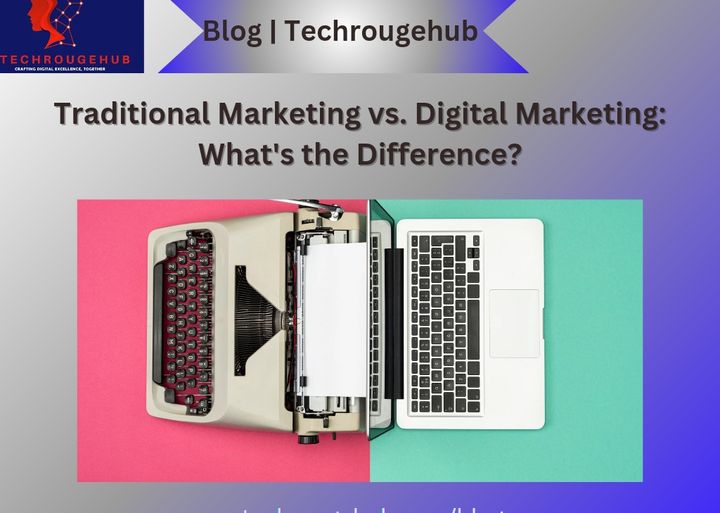Traditional Marketing vs. Digital Marketing: What’s the Difference?
Marketing is a crucial aspect of business that aims to connect businesses with their target audience and drive sales. Traditional marketing and digital marketing are two broad categories that businesses use to achieve these goals. Traditional marketing encompasses conventional methods like print ads in newspapers, radio and TV commercials, billboards, flyers, and direct mail. These channels are tangible and have been used for decades to reach audiences. Digital marketing, on the other hand, leverages online platforms and technologies such as websites, social media platforms like Facebook, Instagram, and Twitter, email marketing, search engine optimization (SEO), and pay-per-click (PPC) advertising. In this blog, we’ll delve into the key differences between these two marketing approaches and explore their unique characteristics and advantages.
1. Nature and Channels
Traditional marketing encompasses conventional methods that have been used for decades. This includes print ads in newspapers and magazines, radio and TV commercials, billboards, flyers, and direct mail. These channels are tangible and are often referred to as ‘offline’ or ‘outbound’ marketing.
Digital marketing, on the other hand, leverages online platforms and technologies to connect with audiences. This includes websites, social media platforms like Facebook, Instagram, and Twitter, email marketing, search engine optimization (SEO), and pay-per-click (PPC) advertising. Digital marketing is often categorized as ‘online’ or ‘inbound’ marketing.
2. Reach and Targeting
Traditional marketing often casts a wider net, targeting a broad audience without specific segmentation. For instance, a TV commercial or a billboard aims to reach as many people as possible, regardless of their interests or demographics.
Digital marketing, however, offers more precise targeting capabilities. Through tools like Google Analytics and Facebook Insights, businesses can identify and target specific audiences based on demographics, interests, online behavior, and more. This enables personalized marketing campaigns that resonate better with potential customers.
3. Cost and ROI
Traditional marketing methods, such as TV and print advertising, can be quite expensive. Producing high-quality commercials or print ads requires significant investment, and there’s no guarantee of reaching the intended audience or achieving desired results.
Digital marketing, on the other hand, offers more cost-effective solutions. Platforms like social media and email marketing allow businesses to reach a large audience at a fraction of the cost of traditional methods. Additionally, digital marketing offers better tracking and analytics capabilities, enabling businesses to measure the ROI of their campaigns more accurately.
4. Flexibility and Adaptability
One of the key advantages of digital marketing is its flexibility and adaptability. Digital campaigns can be easily adjusted in real-time based on performance metrics and customer feedback. This agility allows businesses to optimize their campaigns for better results continuously.
Traditional marketing, due to its static nature, lacks this flexibility. Changes or adjustments to a TV commercial or print ad can be time-consuming and costly, making it challenging to respond quickly to market trends or consumer behavior.
5. Engagement and Interactivity
Digital marketing offers higher levels of engagement and interactivity compared to traditional methods. Social media platforms, for example, enable businesses to interact directly with their audience, respond to comments and feedback, and build stronger relationships.
Traditional marketing, while effective in building brand awareness, often lacks this two-way communication. Consumers passively receive messages from TV commercials or print ads without the opportunity to engage or interact with the brand.
6. Conclusion
In conclusion, both traditional marketing and digital marketing have their strengths and weaknesses, and the choice between them depends on various factors, including the target audience, budget, and marketing objectives. While traditional marketing offers broad reach and brand visibility, digital marketing provides better targeting, cost-effectiveness, flexibility, and engagement.
In today’s digital age, many businesses are integrating both traditional and digital marketing strategies to maximize their reach and effectiveness. By leveraging the strengths of each approach and adapting to changing consumer behavior and market trends, businesses can create holistic marketing campaigns that drive results and achieve their goals.
#traditionalmarketinening #marketingstrategy #MarketingStrategy #OnlineMarketing #OfflineMarketing #Targeting #CostEffective #ROI #Flexibility #Engagement #BusinessStrategy #MarketingChannels #MarketingTrends #IntegratedMarketing #MarketingMix #BrandAwareness #CustomerEngagement #MarketSegmentation

